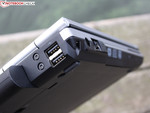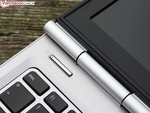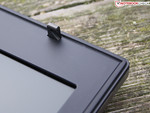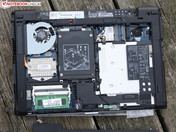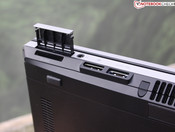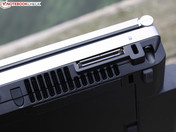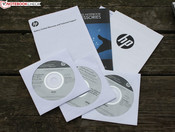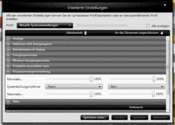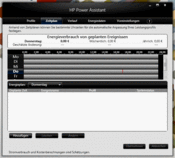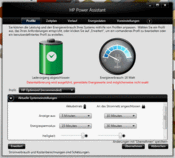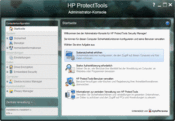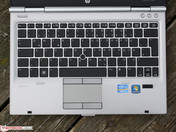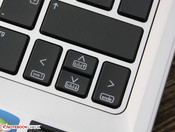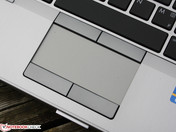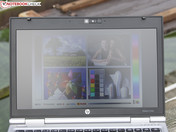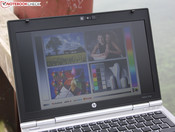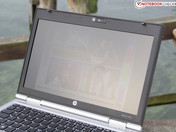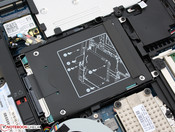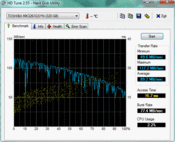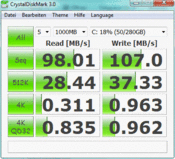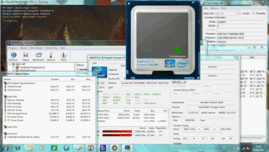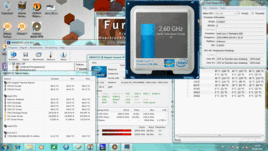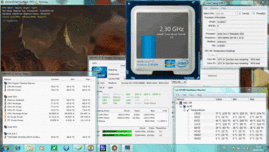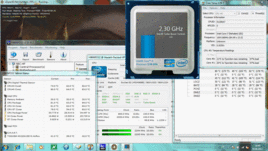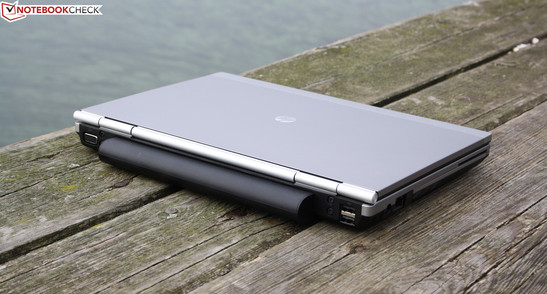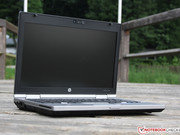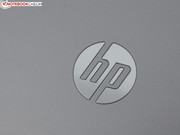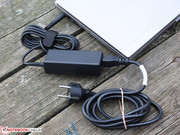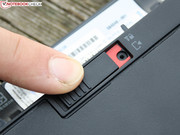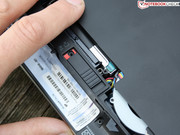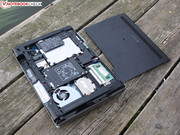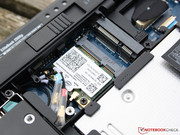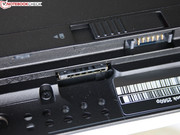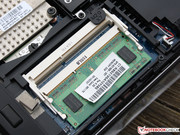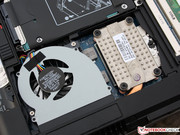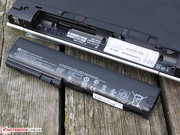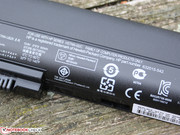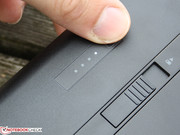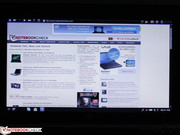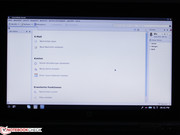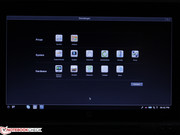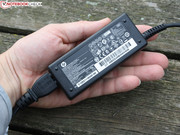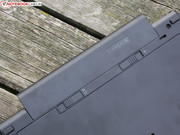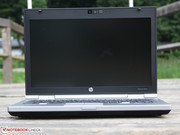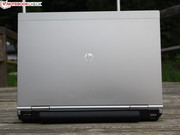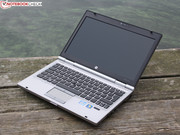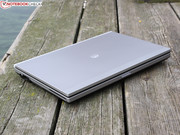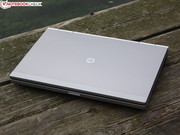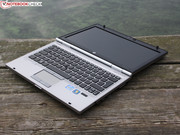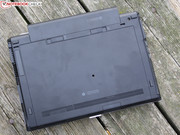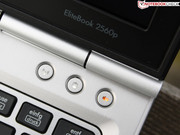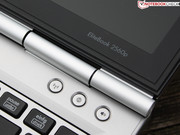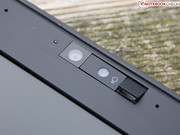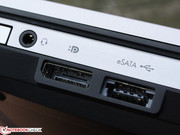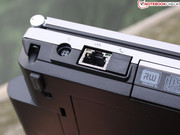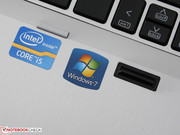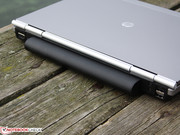Review HP EliteBook 2560p LG666EA Subnotebook

The EliteBooks produced by HP belong to the luxury class of business notebooks. These models usually boast a price tag above 1000 Euros and a high-quality aluminium finish. Any buyer can find the perfect size for themselves thanks to the wide variety of sizes these models come in. In our review, the 15.6 inch 8560p was the heaviest model (3.2 kg), but it also offered the most performance. The smaller 14 inch 8460p had a few problems with CPU throttling, but remained cool and had good workmanship (2.44 kg). Last but not least is the 2760p Tablet PC (convertible), which we have not tested yet.
The smallest EliteBook is a 12.5 inch model named 2560p. We picked the cheapest and the lightest (1.96 kg) configuration: the LG666ET/LG666EA. The market price for this packet lies a little under 1,000 Euros. This packet does not have an integrated UMTS module and comes with a middle-class CPU: Core i5-2410M (2 x 2.60GHz). Does the laptop offer great mobility in exchange for the high price? In the following review, we will explore the features offered by the EliteBook 2560p and determine whether it is the perfect entry-level laptop for buyers looking to get a model from this price-crowned series.
Case
Today's consumers are looking for the thinnest subnotebook available (see Intel Ultrabooks). HP disagrees with this trend and opts instead to add a few hundred grams and a couple of material layers to the 12.5 inch 2560p subnotebook. The 2560p weighs 1.96 kg and sits heavy in the hand. The huge back of the laptop measures 3.5 cm, which is 0.6 cm more than a flat IdeaPad S205 and 1.4 cm more than a Lenovo Edge E125. The EliteBook 2540p (the predecessor of the 2560p) may not have been a light-weight (1,833 grams) but at least it was 130 grams lighter.
However, the relatively heavy weight and unusual size of the laptop makes it sturdy and reliable. HP has picked high-quality, and heavy materials for the 2560p. We believe that they wanted to make the device rugged for business use.
The base unit of the notebook seems impervious. Both the hand-rest regions and the bottom plate of the laptop successfully resisted all our attempts to bend them inwards. The chassis is compact and secure, and HP has managed to design a sturdy bottom plate which requires the removal of no screws to take off. The removal of the bottom plate does not affect the sturdiness of the notebook adversely, as multiple braces on the inside support the chassis.
The sloped display cover protects its charge well. We could barely bend the edges of the cover. The silver sheen of the surface is due to the lacquer applied to the aluminium, which is cool to touch. Fingerprints do not stand a chance, but scratches can appear over time. Bending the cover at any single point is almost impossible. We did manage to push the display cover inwards 1 or 2 mm by applying immense force to the middle of the surface. However, pressure applied over a wide area is easily dispersed by the sturdy cover.
The material picked for the notebook (plain synthetic material, brushed and lacquered aluminium) feels cool to touch and proves resistant to scratches. The hinges of the laptop are a massive affair. They are made of real metal and can be found on top of the base unit. No amount of force could bend or twist them and they fulfilled their duty of holding the display up well. Due to the weight of the chassis, it is possible to pull the display open with one hand.
Another nice feature of the HP device is its display locking mechanism. The display lock of the 2560p consists of two massive metal hooks which stand out of the display. These hooks can not be easily broken. The user can operate the lock mechanism with a single hand by pressing the silver button at the front of the laptop. Similarly, the removal of the battery only requires a single hand to press the slider at the back.
Connectivity
The 12.5 inch model offers almost everything that a work notebook should have. DisplayPort, ExpressCard34, SmartCard-Reader and eSATA are all available on the laptop. HP picked DisplayPort instead of HDMI for video output. An interface for a docking station, which is a "Must Have" for high-quality business laptops, is also available. Sadly, USB 3.0 ports which can be found in other high-quality laptops are missing here.
The laptop lacks a modem interface (RJ11), the screwed-in VGA port and FireWire (i-Link). Any missing interfaces can be added via the ExpressCard34 slot, like, for example, a USB 3.0 controller. The placement of two USB ports and a VGA port on the back is nice. This allows the VGA cable and two USB cables to be pushed out of sight.
Communication
The older Bluetooth 2.1 module and the WLAN-Draft-N (Intel Centrino Advanced-N 6205 AGN) are the only communication modules in the 2560p. Users looking for internet on-the-go will have to pick the LG669EA configuration which offers HSDPA. Our model has a free mini PCIe slot for the HSDPA module (incl. antennas) and a SimCard slot can be found under the battery.
Security
HP has provided a variety of security tools and devices for the notebook. A fingerprint reader, a SmartCard reader and a water-proof keyboard (drain in the bottom plate) are standard for EliteBooks. The HP ProtectTools (entire packet) is the security software. It is comprised of the HP Disk Sanitizer, hard disk encryption, Credential Manager (passwords) and File Sanitizer (deletes file without a trace) and a variety of other tools.
The 2560p is compatible with "Central Management", which means that it can be remotely (via Internet or network) identified and accessed. The TPM Embedded Security Chip 1.2 serves this purpose. The BIOS offers a variety of options, such as, password setup (Enhanced Pre-Boot Security), DriveLock (secures the hard disk with a password), Intel Anti Theft (prevents use of a stolen laptop) and DiskSanitizer (deletion of data securely).
Accessories
Two recovery DVDs are placed in the package (one each for 32 bit and 64 bit Windows 7 Professional). Unfortunately HP delivers the laptop with the 32 bit OS pre-installed, and the HP product page only mentions the 32 bit version. Undesirable software, such as, Norton, can be avoided if the user ticks them off at the first start-up of the notebook.
HP Quick-Web (the middle button of the three keys) is an Instant-On-Software (IOS) which is intended for fast access to the internet and E-mail outside of Windows. This software is great as it not only avoids booting up into Windows but also secures the laptop when connected to an unknown network. So users who start their web presentation using IOS are more secure. For screenshots, see our picture gallery, right column.
HP offers a special docking port for the 12.5 inch 2560p. The LE877AA (for 180 euros) is not compatible with other HP business notebooks but does work with the predecessor model, the 2540p. While the 14 and 15 inch models have the docking port at the bottom, the 2560p has its docking interface on the right side of its case. The docking station offers 4 x USB 2.0, DisplayPort, eSATA, Ethernet, 2x Audio and VGA.
The 9-cell battery slice ("Ultra-Long Battery Life") available for the 2540p is not available for the 2560p (XX6XB/P/W, Li-Ion, 8.850mAh).
Warranty
HP offers a limited warranty of 3 years for the 2560p. The battery only receives a guarantee of one year.
Input Devices
Keyboard
The keys of the laptop have a strong pressure point and medium stroke distance which presents a good typing feel for the user. The 2540p had the cursor keys placed separately in a corner as they were too big. However, in the 2560p the cursor keys are seamlessly integrated into the keyboard. This was achieved by making the "up" and "down" keys smaller. The curved surface of the keys is another nice feature. This makes typing more precise as the chance of the finger sliding sideways is reduced. The keyboard sits securely in its spot and is both input-friendly and sturdy.
Touchpad & Pointstick
The user can use either the conventional touchpad or the "Pointstick" (Synaptics TouchStyk V2.0) for navigation. All the mouse and pointstick keys are made of hard rubber which offers a good grip. The keys have a distinct stroke distance and a broad and light pressure point. In addition, the keys make no noise, leaving the user with no complaints.
The Synaptics-Touch-Pad V7.4 is not very big: diameter of 7.6 centimeters. Thankfully, the clever design utilizes the available space well. The touchpad offers vertical and horizontal scroll bars on the side, but only the vertical scroll bar is marked on the touchpad.
Display
The 12.5 inch (31.75 cm) WXGA display of the EliteBook 2560p has a resolution of 1,366 × 768 pixels (16:9 format) and is anti-glare. The display resolution can be problematic as some big Excel documents, website backends or softwares with fixed measurements can not display all their content with a height of 768 pixels. On the other hand, the predecessor (2540p) had a height of 800 pixels (1.280 x 800, 16:10). Users will have to decide for themselves whether this flaw is problematic or not. Currently, a lot of consumer and professional business laptops have the same resolution (earlier they had a 4:3 format).
The anti-glare prevents reflections, but the black value of 1.07 and the contrast of 145:1 is very low. The 2540p also had the same problem. This WXGA panel is not suited for professional picture editing, as the sRGB color space is clearly missing. In comparison, the Vaio Z13 (picture 3) offers a great panel which even covers the Adobe RGB color space. A display which can cover a passable color space is not rare, as is shown by the fourth and fifth pictures.
| |||||||||||||||||||||||||
Brightness Distribution: 84 %
Center on Battery: 128 cd/m²
Contrast: 145:1 (Black: 1.07 cd/m²)
40.45% AdobeRGB 1998 (Argyll 3D)
58.4% sRGB (Argyll 3D)
39.1% Display P3 (Argyll 3D)
The average brightness of the 12.5 inch model lies at 151 cd/m² which is surprisingly low. We have not seen such low brightness in a notebook for years. In contrast, the predecessor (2540p) had 195 cd/m². Of course, this brightness is enough for indoors use at the office but the laptop does not stand a chance outdoors in the sunlight. We took our photos while there was some cloud cover so the display is still clearly legible.
A perfect outdoors companion needs a brightness level between 240 to 300 cd/m². The battery mode makes matters worse as the brightness falls further to around 128 cd/m² (measurement from the middle of the screen). The light sensor of the notebook was off for our measurements and the outdoors pictures. We deactivated the senor in the BIOS to check our brightness measurements but the end result was the same.
The sensor is seated next to the webcam. The sensor regulates the brightness depending on the brightness of the room. This is good as this saves some power. Still, the sensor is unnecessary as the typical room brightness is 100 cd/m² and the maximum brightness of the display of 151 cd/m² is a very small span.
Stable viewing angles are a problem area for subnotebooks, and the high-quality panel of the 2560p is no exception. In fact the viewing angles are as poor as in the predecessor. 80% of all the notebooks we test have poor viewing angles: vertically very low, horizontally sufficient.
Looking at the display from the side or from above will result in inverted colours and a darker image. The colors start inverting at 10 degrees vertically. Horizontally the situation remains fine till 45 degrees, after which the clear colors invert. We expected more from the elite class but it is a fact that very few subnotebooks such as the Vaio Z13 have great viewing angles.
Performance
The Core i7-2620M (2.7 GHz) is the best CPU the EliteBook 2560p can support. We picked a cheaper alternative, the i5 2410M (2.3 GHz). This Sandy Bridge generation processor can be easily overclocked up to 2.9 GHz using the Turbo technology. The latest Turbo 2.0 can push the CPU even further depending on the temperature (Dynamic Range @ Turbo Frequency Limits).
The HD Graphics 3000 graphics chip is integrated into the CPU and is responsible for displaying all the graphics. There are two RAM slots in the laptop, and one is occupied by a 2,048 MB module, while the other remains free. The BIOS of the notebook is the control center from which the user can configure a variety of features and functions, such as, the webcam, LAN card, Multi CPU on/off, Hyper Threading on/off or special functions (USB Charge off, when % capacity). Very few other manufacturers give the user such extensive control over their device.
So which CPU does the user need? Is a 2410M (2.3GHz - in our test model) enough or is a faster Core i7-2620M (2x 2.70GHz) needed? The Cinebench R10 Single 32bit benchmark gave a clear answer: 3,662 points vs. 4,350 points. The difference of 15% is very small.
Single core calculations are less relevant for everyday use. For everyday use, multi-threading with high clock frequency is more important. The 2410M scores 8,017 points in the Cinebench R10 Multi. On the other hand, the 2620M scored up to 9,450 points in our other test models. Once again, the difference is a mere 15%. In short: the 2410M is more than enough for everyday use.
Interesting: the CPU benchmarks showed the same scores on almost all the 2410M systems. This is the first indication that the 12.5 inch model does not suffer from CPU throttling under heavy load.
On the other hand, the PCMark Vantage (32 bit) benchmark showed an end score of 5,778 points for the 2410M system with HD 3000 graphics. For such a system, this score is low, but that is probably because we ran the 32 bit version of the benchmark. The other test models in our database were tested with the 64 bi PCMark Vantage, and taking a look at other laptops shows that the alternative i7 2620M processor can really boost the score: 7,845 points (Lenovo Thinkpad T420 4236-NGG, 7200 RPM HDD).
The new PCMark 7 benchmark gave a score of 1,594 points which is really low for a 2410M system. Even a Fujitsu Lifebook LH531 (5400 RPM HDD) scored higher: 1,855 points. The low score could once again be due to the 32 bit version of Windows installed on the notebook. An SSD can improve the score as shown by the Toshiba Satellite R830-11C, which is equipped with the same hardware and an SSD: 2,936 points (Toshiba THNSNC128GMLJ, 128GB SSD). A Vaio SA2Z9E/B with an SSD and a 2620M processor (3,488 points) gives us an indication of what kind of score the 2560p LG669EA could reach in the PCMark 7 benchmark. The 2560p would score less as the Vaio SA2 has a dedicated graphics card.
| PCMark Vantage Result | 5778 points | |
| PCMark 7 Score | 1594 points | |
Help | ||
| 3DMark 06 Standard Score | 3069 points | |
Help | ||
As the primary storage device is a standard hard disk, the user should not expect any exceptional values. The HDD Sub-Score of the PCMark Vantage lies at a good 4,190 points. This good performance is mainly due to the fact that the hard disk runs at 7200 rpm. SSDs are much faster (20 to 25 Tsd. points), but they are still new to the laptop market. The hard disk (320 GB) from Toshiba reads at 89 MByte/s in sequential read (HD-Tune), which is a clear indication of how fast it is operating.
The integrated Intel HD Graphics 3000 is not suited for demanding games. Risen does run on the laptop but at a resolution of 800x600 pixels. Call of Duty Black Ops freezes a few times and is no fun at low details. Users who are looking for subnotebooks with gaming power should consider the Vaio SA2Z9E/B with Radeon HD 6630M graphics.
| low | med. | high | ultra | |
|---|---|---|---|---|
| Risen (2009) | 38 | 16 | ||
| Call of Duty: Black Ops (2010) | 26 | 18 |
Emissions
Noise Emissions
Less demanding tasks are accomplished by the laptop relatively quietly at 34 dB(A) (the cooler fan runs at a lower speed). As usual, HP offers a "Fan always on while AC" option in the BIOS. Deactivating this option will lead to the fan switching off temporarily while the laptop is idle (30.5 dB(A)). The only emission in this state is from the hard disk. Thankfully, the storage device does not drone like the 7200 rpm hard disks in the 2010 ProBooks and EliteBooks. The read and write activity of the hard disk is barely audible. A slight clattering noise can be heard with one ear on the notebook: 31.4 dB(A).
The demanding life of a power user can cause the cooling system to turn up to 45 dB(A). At this level, the noise is clearly audible. We could not reach this level with modest load (3DMark2006, 39 dB(A)). A stress test with the Furmark (grapchis load) and Prime95 pushed the laptop to this level. The Prime95 benchmark forces the Core i5 2410M to run all threads at 100%. One upside is that the cooling system is constantly on and does not turn up and down.
Noise level
| Idle |
| 30.5 / 33.8 / 33.8 dB(A) |
| HDD |
| 31.4 dB(A) |
| DVD |
| 37.5 / dB(A) |
| Load |
| 39.7 / 45.4 dB(A) |
 | ||
30 dB silent 40 dB(A) audible 50 dB(A) loud |
||
min: | ||
Temperature
Despite 35 W TDP of the CPU, the laptop is no fan heater. HP shows us how the perfect cooling system for a notebook should look like. The temperatures remain low, even under load. The temperatures in the stress test are not much higher than in the idle stat. The balanced distribution when the laptop is idle is exceptional.
(+) The maximum temperature on the upper side is 30.7 °C / 87 F, compared to the average of 35.9 °C / 97 F, ranging from 21.4 to 59 °C for the class Subnotebook.
(+) The bottom heats up to a maximum of 36.7 °C / 98 F, compared to the average of 39.3 °C / 103 F
(+) In idle usage, the average temperature for the upper side is 26.2 °C / 79 F, compared to the device average of 30.8 °C / 87 F.
(+) The palmrests and touchpad are cooler than skin temperature with a maximum of 29.3 °C / 84.7 F and are therefore cool to the touch.
(±) The average temperature of the palmrest area of similar devices was 28.2 °C / 82.8 F (-1.1 °C / -1.9 F).
No CPU-Throttling
The Turbo-Boost processors of Intel are prone to throttling at high temperatures. In the past few months we tested a variety of models from various manufacturers and under heavy CPU load (sometimes even intensive graphics load) the CPU speed fell below the standard clock frequency. An EliteBook 8460p even went down to 800 MHz. This is annoying for users as the processor is not faulty, but the performance falls through the floor.
Thankfully, the EliteBook 2560p shows no signs of throttling. The standard clock frequency of 2.3 GHz in the Multi-Core stress test stays constant. Single core load can be expected at 2.6 GHz. The power consumption of the device stays constant during the stress test at 48 watts which is another indication that the laptop does not suffer from throttling. So users who want to work at the peak of performance offered by their laptop will find the 2560p a good fit. We could not check the i7 2620M version for throttling so we can not say that other models do not suffer from throttling.
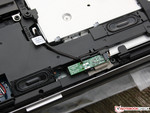
Speakers
The integrated stereo speakers inside the subnotebook are placed under the hand-rest regions and have an opening on the bottom plate. Although they are directed at the table, they still produce sound which is clear and loud. The small membranes of the speaker can not produce any lows and the sound is concentrated on the middles. There is no Virtual Surround Option in the settings of the speaker (IDT 92HD81B1X sound card, 2540p: Intel Audio).
Battery Life
The small notebook consumes very little power. The predecessor (EliteBook 2540p - Core i7-640LM) consumed slightly less. The lowest idle power consumption is 9 watts (2540p: 7.6 W). The maximum idle consumption is 12.9 W (2540p: 12.4 W). In this mode, everything that consumes power is activated (wireless, highest brightness, high performance mode).
The laptop consumes around 48.2 W (2540p: 46.1 W) when the i5 2410M is running with full load and the integrated Intel HD 3000 is busy with the Furmark benchmark. So it is no surprise that the laptop battery lasts around 1 hour and 32 minutes under load (not stress test, BatteryEater Classic). The small 65 W power adapter is well-dimensioned and heats up to a maximum of 48 degrees when in use.
| Off / Standby | |
| Idle | |
| Load |
|
Key:
min: | |
The 12.5 inch model is equipped with a 55 Wh battery (4,910 mAh). The 2540p has 62 Wh. So is the runtime dropping? On the contrary, it is getting better. The laptop lasts 6:39 hours while surfing on the web (399 minutes, 2540p: 275). A film played with the DVD drive drains the laptop in 4 hours and 40 minutes (280 minutes, 2540p: 241). The brightness was set at 100 cd/m² in both tests. The wireless modules (Bluetooth, WLAN) were inactive in the DVD test.
Careful users can reach 10 hours (2540p: 7:50) with maximum energy-saving. This runtime was calculated with the BatteryEater Reader test. The brightness of the panel was set to the lowest level and all the wireless modules were deactivated. The processor was also idle, which makes this scenario rather unrealistic.
Verdict
The HP EliteBook 2560p (version LG666EA) will not get the same great rating from us its predecessor, the 2540p, got. The main reason for this decision is the low TFT brightness. This is especially a problem in battery mode, when the brightness falls further and can even exhaust the user. Users will be frustrated with a brightness of 128 cd/m² (battery mode; sensor off) during daylight hours. With this brightness level, even the decent anti-glare display suffers and can only display a dark desktop. While plugged in, this issue persists although the brightness rises to 151 cd/m².
We do not understand why the competition has better displays, especially the Thinkpad X220 which is in the same price range, has an attractive IPS display and scores extremely well in this area.
However, the weak display rating is not enough to sink the ship. The very good, even excellent, workmanship, sturdiness, and input devices, including the trackpoint, are all huge positives. Another pro is that the laptop also stays cool all the time.
We really liked how HP dealt with the Turbo Boost throttling problem. This ugly problem never turned up during our tests. This is a good sign, as the EliteBook 8460p had massive throttling issues, and this indicates that HP is learning from its mistakes. In addition, the laptop offers a multitude of ports and interfaces, like a docking port interface, a SmartCard reader (chip reader), etc. All of which offer extensive connectivity for the user and should open a few doors for them. The battery run times of up to 6:39 hours is exceptional for a subnotebook without a "Low Voltage" processor (here 35 W).
The program performance is good thanks to the Core i5 2410M (2.3 GHz) and the 7200 rpm hard disk. This performance should suffice for most business and private applications (except for games). The predecessor's slow 1.8 inch model has been replaced by a standard 2.5 inch hard disk. The hike in the price when a Core i7-2620M is picked (2.70GHz, also dual-core), is not justifiable unless the user really needs every second of processing power or he/she is looking for more advanced features such as (Virtualisation). The SSD LG669EA model (128 GB) is really attractive, as, although we do not yet know which SSD HP has picked for the laptop, we can conclude from our past experience with laptops equipped with SSDs, that the 2560p program performance will shoot through the roof with an SSD installed.
If the dark TFT which prevents outdoors use is not a deal-breaker, then the 2560p can be (almost) called a perfect companion for the demanding business user. The pricing of the 2560p is another pro, as the consumer will be happy to know that the 12 inch 2540p from 2010 cost 1,370 Euros in its basic configuration, while the manufacturer now requests 1,000 Euros. The premium SSD model of 2010 cost 2,048 Euros. This price has dropped down to around 1,500 Euros now.




